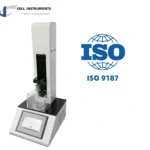


Ampoule Breaking Force Test|Ampoule Quality Test
- Download Catalog
The key to quality testing of ampoules: breaking force test and application of ampoule breaking tester
In the pharmaceutical industry, ampoules are an important carrier for pharmaceutical packaging, and ampoule quality is directly related to the safety and effectiveness of pharmaceuticals. Therefore, it is particularly important to conduct strict quality testing of ampoules. Among them, the breaking force test is one of the key links to evaluate the quality of ampoules, and the ampoule breaking tester is an important tool to achieve this test.
Breaking Force Test
The breaking force test is designed to evaluate the mechanical properties of ampoules during the breaking process to ensure their safety and convenience in actual use. Through the breaking force test, we can understand the breaking force of the ampoule, the accuracy of the breaking position, and the fragments after breaking, so as to determine whether it meets the usage requirements.
Ampoule Breaking Tester
Ampoule breaking tester plays a key role in the breaking force test. This equipment uses a precise mechanical measurement system that can simulate the breaking process in actual use and accurately measure the breaking force of ampoules. At the same time, the ampoule breaking tester is also highly automated in data processing and movement, greatly improving testing efficiency and accuracy.
BST-01 Ampoule Breaking Tester is a type device in pharmaceutical industry.
Benefits and Technical Features
BST-01 Ampoule Breaking Tester is very useful and advanced, and it can be used in many ways in the pharmaceutical and medical fields. It has special features like a steady speed, strong stability, and PLC control to make sure tests are accurate. It also has a stepper motor that controls the speed very precisely. Plus, it’s very safe to use because it has a tube to collect broken samples and a cover to protect samples from jumping during testing.
1. Ampoule support fixture work for different volumes of 1ml, 2ml, 5ml, 10ml, and 20ml. This covers the most frequently used ampoule specifications.
2. Applications can be extended to other tests for medical devices and packaging materials.
3 . For safety, the tester has auto return function, overtravel, and overload protection.
4. Adjustable test speed to suit different requirements.
5. A dot matrix type microprinter is embedded to export a paper test slip for long-term reference.
6. A transparent protective cover is included for safety operation and observation of test process.
7. RS 232 Port and professional software are optional parts if user wants to have data export.
Specifications of BST-01 Ampoule Breaking Tester
| Test Range | 0~200N (Or as required) |
| Stroke | 200mm (without clamp) |
| Speed | 1~500mm/min(or as required) |
| Displacement Accuracy | 0.01mm |
| Accuracy | 0.5% F.S. |
| Output | Screen, Microprinter, RS232(optional) |
| Power | 110~ 220V 50/60Hz |
Standards
Multiple standards, including ISO 9187, GB 2637, and YBB00332002, regulate the evaluation of ampoule breaking strength
Q&A
N/A
Configuration
Main machine, ampoule holder, probe, microprinter, loadcell, protection cover, power cord
Software, customized probe, extra loadcell, COM Line, etc
How to Operate BST-01 Ampoule Breaking Tester
ISO 9626
ISO 9626 Stainless Steel Needle Tubing Test ISO 9626 specifies the requirements and test methods for stainless steel needle tubing used in the manufacture of medical devices such as hypodermic needles and cannulas. This international standard ensures that the tubing used in medical applications meets consistent performance and safety requirements.
System Suitability Testing Pharmacopoeia for Glass Ampoules
System suitability testing pharmacopoeia is a cornerstone of pharmaceutical quality assurance. When dealing with injectable drugs packaged in glass ampoules, international standards such as ISO 9187 establish strict criteria for hydrolytic resistance, annealing quality, and breaking force. By following these procedures, manufacturers not only meet regulatory expectations but also safeguard
Package Compression Test
Package Compression Test The package compression test is a vital method used across packaging, pharmaceutical, and medical industries to evaluate the structural integrity of packaging materials. This test simulates real-world pressure conditions that packaging may encounter during transportation, stacking, or handling. It ensures that packaging does not rupture, deform, or
Sodium Chloride Ampoule Force Testing Guide for ISO 9187-1 Compliance
Introduction to Sodium Chloride Ampoules Sodium chloride ampoule is a widely used packaging format in the pharmaceutical industry, commonly serving injectable solutions for clinical and hospital use. These ampoules must meet strict safety and quality standards to ensure sterile conditions and break integrity. One of the essential performance indicators is

Ampoule Mechanical Strength Tester According to ISO 9187
Introduction Accurate evaluation of ampoule mechanical strength tester is critical in pharmaceutical quality control. Glass ampoules used for injectable solutions must be strong enough to maintain sterility during transportation and storage, yet easy enough to break open without excessive force. ISO 9187 provides standardized test procedures to assess these qualities,
Maximizing Package Integrity with Packaging Compression Strength Tester
Maximizing Package Integrity with Packaging Compression Strength Tester In today’s fast-paced logistics and pharmaceutical supply chains, packaging compression strength tester solutions are indispensable for safeguarding product quality and consumer safety. At Cell Instruments, we understand the significance of maintaining packaging integrity under real-world stress. This article provides a professional yet